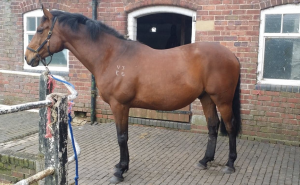
Horse: Warmblood
Age: 13 years old at time of incident.
History
This gelding has been barefoot his whole life. He had functional feet from a comfort perspective, although a tendency to be low heeled and flatfooted. He was also often a little bloated and generally a ‘grumpy guts’.
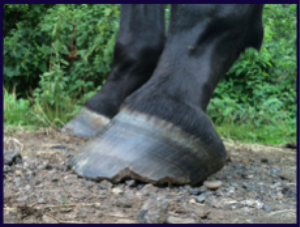
The left fore in 2015 – prior to first trim. Some cracks in the lower hoof wall.
In the autumn of 2017 the owner and EP noticed that we were getting another bout of cracks to the hooves. The gelding was however moving well and comfortably and we discussed some tweaks to the diet and trim to see if we could improve them.
Then in April 2018 the horse was brought in on a Friday night with acute lameness and swelling on the left fore. The horse has had a history of tendon injuries and so it was assumed that this was the problem and he was box rested for the weekend. Whilst he was kept in, the owner took the opportunity to worm him. When the vet came on the Monday to see him, she found no sign of the original acute lameness and the swelling, but found that he was presenting as bilaterally lame in front.
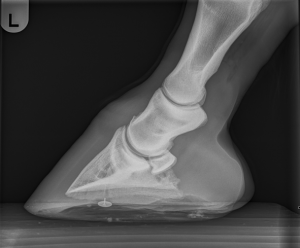
The left fore in 2018 – ground parallel pedal bone, thin sole and bony column sitting low in the hoof capsule
Radiographs followed and confirmed that the pedal bone angles were low and providing little protection to the navicular area. If a horse loses strength and ‘heart’ to the heel structures, the support to rear portion of the pedal bones is reduced and so the bones become more ground parallel. This is undersirable as the foot is then less able to absorb shock and protect the bony column and navicular area.
The EP on the subsequent consultation noted that the frogs were looking much weaker and had recessed into the sole which is indicative of a sinker situation. Sinker occurs where the bones of the foot sit lower in the hoof capsule, putting more pressure of the sole of the foot. It normally results in significant discomfort for the horse and would account for the horse’s loss of his former comfort. He was not loading his heels in front and was presenting with his ‘grumpy guts’ demeanour.
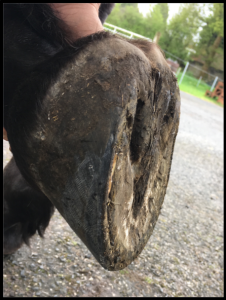
The left fore in April 2018 the sole is very pronounced and the frogs recessed and weak
So we realised that we needed to protect the sole and heel area and support gut health. We wanted to see the return of the slight heel first landings that we knew would enable him to rebuild the strength of the heel structures and improve the pedal bone angles.
Approach
Initally the horse was put into boots and pads for turnout to provide comfort to the heels and soles. However when the hot summer of 2018 started it was found that being 24/7 in boots and pads wasn’t working due to sweating and rubs – we needed a plan B! The attending Equine Podiatrist consulted collegues for assistance and the suggestion came back to use Equus Hoofcasts which are a water activated resin material which is wrapped around the hoof capsule and then sets. Casts are helpful in that they protect the soles, and also limit how far the hoof capsule can expand under load. This was desirable in this case as we suspected that over expansion of the weak heel structures, causing pressure into the navicular area was the reason that the horse was avoiding landing heel first.
Under veterinary approval, hoof casts were applied to the front feet only. Videos were taken of the hoof landings before and after the cast were applied and demonstrated that the horse’s landings were improved. Around this time the digestive support product Effective Microorgansims (EM1) was also introducted into the diet. Three cycles of the casts were applied over a period of about four months, the casts would generally stay on the foot for three to four weeks so the foot had some time without them as well during each trim cycle. This allowed the horse to regain heel height and sole depth.
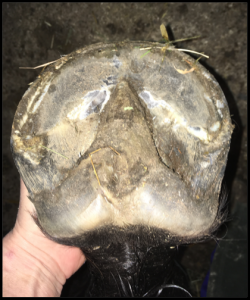
The left fore in March 2019 the sole now has concavity, the heels have more height and the frogs have recovered.
By the late summer the gelding was reliably landing heel first and the soles were regaining concavity; it was decided that the casts were no longer needed. Over autumn winter 2018 he was turned out barefoot and worked with boots and pads. Really noticably he had also lost the ‘grumpy guts’ look to his physique and character. The owner and EP surmised that the long hot- very little fresh grass – summer of 2018 and the EM1 had really settled down the digestive issues that may have underpinned the problems he had had after the original lameness and worming. The gelding is now back in full work both barefoot and booted depending on the siutation and hasn’t looked back.
This case was a good example of the teamwork between the owner, vet, Equine Podiatrist and the wider resources and knowledge of the Equine Podiatry Association. It meant we were able to recover the hooves relatively quickly and the horse was able to return to work once the issue with the hoof weakness, landings and gut discomfort was identified and addressed.